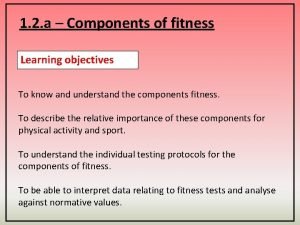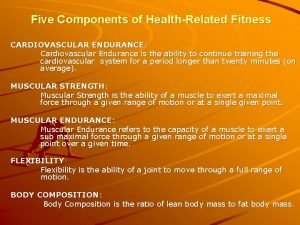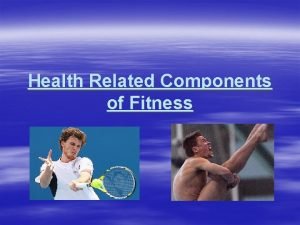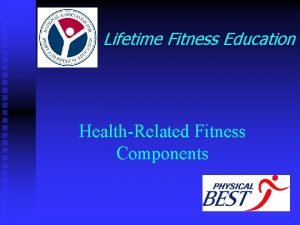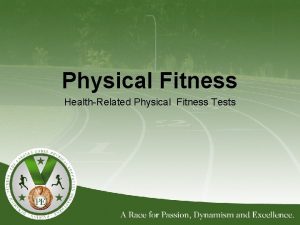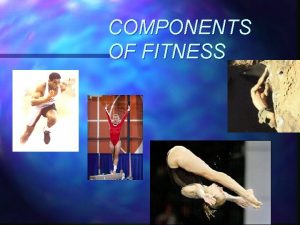1 05 Identify the healthrelated components of fitness





- Slides: 5

1. 05 Identify the health-related components of fitness. Module 1 Explain the importance of being physically active. Identify activities that develop each health-related fitness component. Describe the short-term and long-term benefits of regular physical activity. List safety procedures related to activities that improve each health-related fitness component. Identify the various physical activities that you can be involved in regularly 1. 03 Identify common safety practices related to physical activity. Select and utilize appropriate equipment for various physical activities. Recognize the difference between fact and fiction as it relates to physical fitness products and programs. Practice two activities related to each of the health components. 1. 06 Differentiate between aerobic and anaerobic activities. Describe the benefits of aerobic and anaerobic activities. Demonstrate the movements designed to improve and maintain cardiorespiratory endurance, muscular strength and endurance, flexibility, and proper body composition. 1. 07 Describe the effects of physical activity on heart rate. Describe how to monitor a carotid and a radial pulse. 1. 04 Describe the precautions to be taken when exercising in extreme weather. Calculate the target heart rate zone and compare the methods of monitoring heart rate during exercise. Identify the three different types of heat illnesses associated with fluid loss. List the methods of monitoring intensity level during aerobic activity Explain the need for warm up and cool down activity. Practice the basic warm up and cool down exercises. 1. 08 Describe the SPORT and FITT principles of training. Demonstrate how the principles of training apply to specific physical activities

Module 2 Learning Goals Module 2 Identify opportunities to participate in a variety of physical activities through sports, outdoor pursuits, and aquatics. Identify elements important to successfully perform a variety of sports and physical activities. Relate how movements and strategies learned in one physical activity improve performance in other activities. 2. 05 Describe how balance, posture, and weight transfer contribute to success in physical activities. Describe procedures and equipment required to improve speed, agility, and 2. 02 reaction time. Analyze the speed, agility, and reaction time of yourself and a partner while performing striking skills and other physical activities. Suggest how speed, agility, and reaction time can improve efficiency in performance in a variety of activities. 2. 06 Identify basic rules of sports and games Describe procedures and equipment required to improve balance and 2. 03 coordination. Analyze the balance and coordination of yourself and a partner while performing striking skills and other physical activities. 2. 07 Identify safety equipment and practices related to aquatics Perform basic aquatics activities in water or on land Identify how balance and coordination can improve efficiency in performance in a variety of physical activities. 2. 04 Describe procedures and equipment required to improve power. Analyze the power of yourself and a partner while performing striking skills and other physical activities. Identify how power can improve efficiency in performance in a variety of physical activities. 2. 08 Demonstrate basic outdoor pursuit skills Identify safety equipment and practices related to outdoor pursuits

Module 3 Learning Goals Identify the benefits of doing physical activities with others. Module 3 Identify opportunities to participate in a variety of physical activities through individual, alternative and extreme sports. 3. 02 Explain how making the right choices help individuals and teams enjoy group activities. Modify a game or activity for a person of diverse background or abilities. Demonstrate the importance of proper care of equipment, respect for facilities, appropriate etiquette and safe behaviors. 3. 03 Identify a variety of dual activities. Explain rules and equipment commonly used in a variety of dual activities 3. 04 Identify a variety of alternative and extreme activities Participate in an alternative and extreme activity 3. 05 Identify a variety of team sports. Participate in a team sports activity 3. 06 Explain offensive and defensive strategies appropriate for a variety of sports. Describe and perform appropriate strategies and tactics for a specific activit

Locate and participate in an enjoyable physical activity outside of school. Module 4 List benefits of participating in a variety of physical activities. 4. 02 Assess your motivation and results of your physical activity plan. 4. 03 Recognize peer pressure. Identify the difference between positive and negative peer pressure. Know how to deal with negative peer pressure. 4. 04 Demonstrate responsible behaviors during physical activity. Identify good personal, social, and ethical behavior in a physical activity setting 4. 05 Understand how to accept and respect people of diverse backgrounds and abilities in physical activity settings. 4. 06 Define calories and explain how the body obtains energy from foods. Document and analyze calories consumed and energy expended. Suggest how adjusting caloric input and output affects body composition over time.

Module 5 Learning Goals Identify healthy and unhealthy practices. Module 5 Determine how factors of family health history can impact your own health. Identify chronic diseases that may impact your body and health. Identify behaviors that eliminate or reduce health risks. 5. 02 Determine reliability of health information. Determine which health agencies can offer help and when it is appropriate. Analyze health products and services for value and reliability. Recommend health aids that gather health information. 5. 03 Identify positive and negative peer pressure. Understand use a decision-making model. Distinguish when individual or collaborative decision-making is appropriate. Use effective communication skills to say no to risky behavior. Choose healthy alternatives when making difficult decisions. 5. 04 Analyze the relationship between healthy behaviors and personal health. Assess the importance of taking responsibility for your personal behaviors 5. 05 Analyze how you are influenced by peers and family to be healthy or unhealthy. Describe consequences when being influenced by peers and family. Critique and explain how norms of society influence you. 5. 06 Work cooperatively to advocate for healthy individuals, peers, families, and schools. Evaluate ways health messages and communication techniques can be targeted for different audiences. Research marketing strategies behind health-related media messages. Analyze the influence of technology on personal and family health.

